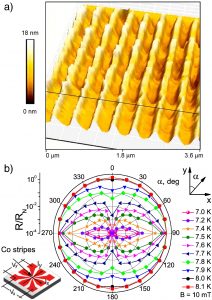Focused electron beam induced deposition meets materials science
M.Huth, F.Porrati and O.V.Dobrovolskiy
Microelectronic Engineering
Volumes 185–186, 5 January 2018, Pages 9-28
Focused electron beam induced deposition (FEBID) is a direct-write method for the fabrication of nanostructures whose lateral resolution rivals that of advanced electron beam lithography but is in addition capable of creating complex three-dimensional nano-architectures. Over the last decade several new developments in FEBID and focused electron beam induced processing (FEBIP) have led to a growing number of scientific contributions in solid state physics and materials science based on FEBID-specific materials and particular shapes and arrangements of the employed nanostructures. In this review an attempt is made to give a broad overview of these developments and the resulting contributions in various research fields encompassing mesoscopic physics with nanostructured metals at low temperatures, direct-write of superconductors and nano-granular alloys or intermetallic compounds and their applications, the contributions of FEBID to the field of metamaterials, and the application of FEBID structures for sensing of force or strain, dielectric changes or magnetic stray fields. The very recent development of FEBID towards simulation-assisted growth of complex three-dimensional nano-architectures is also covered. In the review particular emphasis is laid on conceptual clarity in the description of the different developments, which is reflected in the mostly schematic nature of the presented figures, as well as in the recurring final sub-sections for each of the main topics discussing the respective “challenges and perspectives”.
Our group demonstrated for the first time that nanostructures
fabricated by FEBID can be used for the extension of the dissipationfree
state of superconductors to higher temperatures and larger
currents.
https://doi.org/10.1016/j.mee.2017.10.012
Anomalous Josephson effect controlled by an Abrikosov vortex
Phys. Rev. B Vol. 96, Iss. 21 — 1 December 2017
The possibility of a fast and precise Abrikosov vortex manipulation by a focused laser beam opens the way to create laser-driven Josephson junctions. We theoretically demonstrate that a vortex pinned in the vicinity of the Josephson junction generates an arbitrary ground state phase which can be equal not only to 0 or π but to any desired φ0 value in between. Such φ0 junctions have many peculiar properties and may be effectively controlled by the optically driven Abrikosov vortex. Also we theoretically show that the Josephson junction with the embedded vortex can serve as an ultrafast memory cell operating at sub THz frequencies.
The dependencies of the ground state phase ϕ0 on the dimensionless vortex position X0 along the junction for different values of the phase jump κ. The value δκ/π=(κ−π)/π is equal to (a) −0.02; (b) −0.01; (c) −0.0015; (d) −0.0001; (e) 0; (f) 0.0001; (g) 0.0015; (h) 0.01; (i) 0.02. The blue solid lines correspond to the stable branches realizing the minima of the free energy while the red dashed curves show the metastable solutions for ϕ0.
https://doi.org/10.1103/PhysRevB.96.214515


